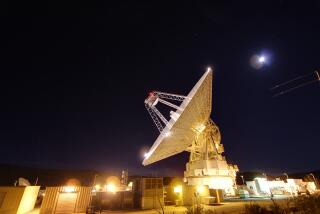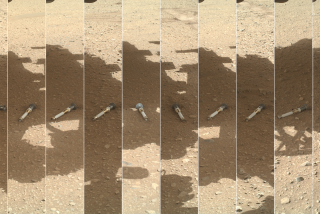Cuts Imperil NASA Safety, Panel Warns
Strapped by budget cuts, hiring freezes, buy-outs and early retirements, NASA now faces a manpower âcrisisâ that may soon leave it without the expertise it needs to manage Americaâs space program safely, the agencyâs independent safety panel warned Thursday.
The shortage of trained technicians at the National Aeronautics and Space Administrationâs manned space flight centers âcan jeopardize otherwise safe operations.â Moreover, the agencyâs inability to attract new scientific talent clouds its future, the safety experts said in their annual assessment of the agencyâs programs.
William Readdy, head of NASAâs space shuttle program, acknowledged Thursday that the agency has not been able to hire the new engineers and scientists it would like, but said that budget cuts and hiring freezes have not eroded NASAâs commitment to safety.
Independent space policy analysts, however, said the panelâs warnings about the agencyâs personnel cuts should be taken seriously.
âNASA has been cutting into muscle and bone,â said John Pike, space policy director at the Federation of American Scientists. âThey were taking a calculated risk they could reduce overall staff and cut the number of safety and quality assurance inspectors, without appreciably increasing the risk of another Challenger accident.â
The work force situation is especially important as NASA starts the ambitious construction of a $50-billion international space station. âThere are no clear plansâ for handling the extra demands imposed by the space shuttle flights needed to ferry materials and work crews into orbit, the panel concluded.
âThis is a critical problem,â the safety experts reported.
The space agency launched the shuttle only five times last year, but the number of flights necessary for the 16-nation space station is expected to reach more than eight a year, greater than at any time since the Challenger accident in 1986, which killed seven astronauts and destroyed the $2-billion spaceship.
In all, the 1-million-pound orbiting space station--the size of two football fields--will require five years, more than 40 shuttle launches and 1,700 hours of spacewalks to construct.
But it is the agencyâs own future that concerned the panel most.
âSafety in the short run is well-served,â said panel chairman Richard D. Blomberg. âThe long-term picture is less certain.â
With twice as many scientists and engineers over the age of 60 as under the age of 30, NASA faces an exodus of its top talent in the next few years that could leave it without the expertise to conduct safe spaceflight operations.
NASA officials are juggling existing obligations like the space station program even as they look for ways to fund new efforts, like the Stardust spacecraft set for launch Saturday on a mission to capture samples of comet dust.
NASA is hardly alone in its struggle to do more with less, as tight budgets have become a permanent fact of federal financial life. But the very nature of the agencyâs mission--to lead the human exploration of space--makes it unique in the federal government.
Overall, the agency has cut more than 6,100 employees in seven years.
At NASAâs Kennedy Space Center, the shuttle work force has been cut by 50% in the past five years, down to 3,800 contractors and 600 civil servants. At the Jet Propulsion Laboratory in Pasadena, employment has been cut by about 775 people during the same period, down to 5,009 engineers, scientists and support staff.
To make ends meet in the manned space program, the agency is turning over day-to-day operation of its fleet of four space shuttles to a private contractor called the United Space Alliance.
Readdy at NASA said the agency has been worried enough about pending retirements that it recently started a formal assessment of its in-house scientific and engineering needs.
âWe do need to start hiring again,â Readdy said. âWe want to start growing the next generation of researchers, engineers and explorers.â
But the safety panel âis especially concerned that the normal patterns of bringing new technical and managerial leadership into NASA have been seriously disrupted.â
Even though there is no longer an agency hiring freeze, âbudgetary restrictions make it all but impossible to replace experienced persons who are leaving,â the panel said. âIn those circumstances, the question of who will be available and fully qualified to lead NASAâs human space flight programs [after] 2005 has become real.â
More to Read
Sign up for Essential California
The most important California stories and recommendations in your inbox every morning.
You may occasionally receive promotional content from the Los Angeles Times.










